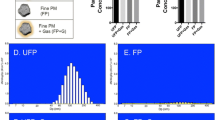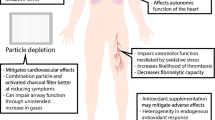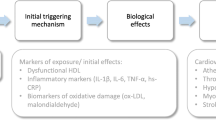Abstract
Roadside proximity and exposure to mixed vehicular emissions (MVE) have been linked to adverse pulmonary and vascular outcomes. However, because of the complex nature of the contribution of particulate matter (PM) versus gases, it is difficult to decipher the precise causative factors regarding PM and the copollutant gaseous fraction. To this end, C57BL/6 and apolipoprotein E knockout mice (ApoE−/−) were exposed to either filtered air (FA), fine particulate (FP), FP+gases (FP+G), ultrafine particulate (UFP), or UFP+gases (UFP+G). Two different timeframes were employed: 1-day (acute) or 30-day (subchronic) exposures. Examined biological endpoints included aortic vasoreactivity, aortic lesion quantification, and aortic mRNA expression. Impairments in vasorelaxation were observed following acute exposure to FP+G in C57BL/6 animals and FP, UFP, and UFP+G in ApoE−/− animals. These effects were completely abrogated or markedly reduced following subchronic exposure. Aortic lesion quantification in ApoE−/− animals indicated a significant increase in atheroma size in the UFP-, FP-, and FP+G-exposed groups. Additionally, ApoE−/− mice demonstrated a significant fold increase in TNFα expression following FP+G exposure and ET-1 following UFP exposure. Interestingly, C57BL/6 aortic gene expression varied widely across exposure groups. TNFα decreased significantly following FP exposure and CCL-5 decreased in the UFP-, FP-, and FP+G-exposed groups. Conversely, ET-1, CCL-2, and CXCL-1 were all significantly upregulated in the FP+G group. These findings suggest that gas–particle interactions may play a role in vascular toxicity, but the contribution of surface area is not clear.






Similar content being viewed by others
References
Hoffmann, B., et al. (2007). Residential exposure to traffic is associated with coronary atherosclerosis. Circulation,116(5), 489–496.
Mills, N. L., et al. (2009). Adverse cardiovascular effects of air pollution. Nature Clinical Practice Cardiovascular Medicine,6(1), 36–44.
Pope, C. A., 3rd, et al. (2011). Vascular function and short-term exposure to fine particulate air pollution. Journal of the Air and Waste Management Association,61(8), 858–863.
Ruidavets, J. B., et al. (2005). Ozone air pollution is associated with acute myocardial infarction. Circulation,111(5), 563–569.
Wellenius, G. A., et al. (2012). Ambient air pollution and the risk of acute ischemic stroke. Archives of Internal Medicine,172(3), 229–234.
Maynard, A. D. A. E. D. K. (2005). Airborne nanostructured particles and occupational health. Journal of Nanoparticle Research,7(6), 587–614.
Schwarze, P. E., et al. (2006). Particulate matter properties and health effects: consistency of epidemiological and toxicological studies. Human and Experimental Toxicology,25(10), 559–579.
Dockery, D. W., et al. (1993). An association between air pollution and mortality in six U.S. cities. The New England Journal of Medicine,329(24), 1753–1759.
Vedal, S., et al. (2013). National Particle Component Toxicity (NPACT) initiative report on cardiovascular effects. Research Report/Health Effects Institute,178, 5–8.
Campen, M., et al. (2014). Engine exhaust particulate and gas phase contributions to vascular toxicity. Inhalation Toxicology,26(6), 353–360.
Tyler, C. R., et al. (2016). Surface area-dependence of gas-particle interactions influences pulmonary and neuroinflammatory outcomes. Particle and Fibre Toxicology,13(1), 64.
Bai, N., et al. (2011). Changes in atherosclerotic plaques induced by inhalation of diesel exhaust. Atherosclerosis,216(2), 299–306.
Campen, M. J., et al. (2010). Inhaled diesel emissions alter atherosclerotic plaque composition in ApoE(−/−) mice. Toxicology and Applied Pharmacology,242(3), 310–317.
Hansen, C. S., et al. (2007). Diesel exhaust particles induce endothelial dysfunction in apoE−/− mice. Toxicology and Applied Pharmacology,219(1), 24–32.
Hazari, M. S., et al. (2011). TRPA1 and sympathetic activation contribute to increased risk of triggered cardiac arrhythmias in hypertensive rats exposed to diesel exhaust. Environmental Health Perspectives,119(7), 951–957.
Quan, C., et al. (2010). Comparative effects of inhaled diesel exhaust and ambient fine particles on inflammation, atherosclerosis, and vascular dysfunction. Inhalation Toxicology,22(9), 738–753.
Miller, M. R., et al. (2013). Diesel exhaust particulate increases the size and complexity of lesions in atherosclerotic mice. Particle and Fibre Toxicology,10, 61.
Araujo, J. A., et al. (2008). Ambient particulate pollutants in the ultrafine range promote early atherosclerosis and systemic oxidative stress. Circulation Research,102(5), 589–596.
Sun, Q., et al. (2005). Long-term air pollution exposure and acceleration of atherosclerosis and vascular inflammation in an animal model. JAMA,294(23), 3003–3010.
Lund, A. K., et al. (2007). Gasoline exhaust emissions induce vascular remodeling pathways involved in atherosclerosis. Toxicological Sciences,95(2), 485–494.
Bisig, C., et al. (2018). Assessment of lung cell toxicity of various gasoline engine exhausts using a versatile in vitro exposure system. Environmental Pollution,235, 263–271.
Lund, A. K., et al. (2011). The oxidized low-density lipoprotein receptor mediates vascular effects of inhaled vehicle emissions. American Journal of Respiratory and Critical Care Medicine,184(1), 82–91.
Lennox Siwale, L. K., Adam, T., Bereczky, A., Mbarawa, M., Penninger, A., & Kolesnikov, A. (2013). Combustion and emission characteristics of n-butanol/diesel fuel blend in a turbo-charged compression ignition engine. Fuel,107, 409–418.
Frank Ruiz, M. C., Lopez, A., Sanchez-Valdepenas, J., & Agudelo, J. R. (2015). Impact of dual-fuel combustion with n-butanol or hydrous ethanol on the oxidation reactivity and nanostructure of diesel particulate matter. Fuel,161, 18–25.
Cheung, C. S., Zhu, L., & Huang, Z. (2009). Regulated and unregulated emissions from a diesel engine fueled with biodiesel and biodiesel blended with methanol. Atmospheric Environment,43(32), 4865–4872.
de Brito, J. M., et al. (2018). Acute exposure to diesel and sewage biodiesel exhaust causes pulmonary and systemic inflammation in mice. Science of the Total Environment,628–629, 1223–1233.
Cassee, F. R., et al. (2012). The biological effects of subacute inhalation of diesel exhaust following addition of cerium oxide nanoparticles in atherosclerosis-prone mice. Environmental Research,115, 1–10.
Zhang, J., et al. (2013). Impacts of a nanosized ceria additive on diesel engine emissions of particulate and gaseous pollutants. Environmental Science and Technology,47(22), 13077–13085.
Snow, S. J., et al. (2014). Inhaled diesel emissions generated with cerium oxide nanoparticle fuel additive induce adverse pulmonary and systemic effects. Toxicological Sciences,142(2), 403–417.
McDonald, J. D., et al. (2004). Generation and characterization of four dilutions of diesel engine exhaust for a subchronic inhalation study. Environmental Science and Technology,38(9), 2513–2522.
McDonald, J. D., et al. (2008). Generation and characterization of gasoline engine exhaust inhalation exposure atmospheres. Inhalation Toxicology,20(13), 1157–1168.
Herring, C. L., Faiola, C. L., Massoli, P., Sueper, D., Erickson, M. H., McDonald, J. D., et al. (2015). New methodology for quantifying polycyclic aromatic hydrocarbons (PAHs) using high-resolution aerosol mass spectrometry. Aerosol Science and Technology,49(11), 1131–1148.
Aragon, M., et al. (2016). MMP-9-dependent serum-borne bioactivity caused by multiwalled carbon nanotube exposure induces vascular dysfunction via the CD36 Scavenger receptor. Toxicological Sciences,150(2), 488–498.
Aragon, M. J., et al. (2016). Inflammatory and vasoactive effects of serum following inhalation of varied complex mixtures. Cardiovascular Toxicology,16(2), 163–171.
Brook, R. D., et al. (2010). Particulate matter air pollution and cardiovascular disease: An update to the scientific statement from the American Heart Association. Circulation,121(21), 2331–2378.
Pope, C. A., 3rd. (2007). Mortality effects of longer term exposures to fine particulate air pollution: review of recent epidemiological evidence. Inhalation Toxicology,19(Suppl 1), 33–38.
Pope, C. A., 3rd, et al. (2004). Cardiovascular mortality and long-term exposure to particulate air pollution: epidemiological evidence of general pathophysiological pathways of disease. Circulation,109(1), 71–77.
Hoffmann, B., et al. (2009). Chronic residential exposure to particulate matter air pollution and systemic inflammatory markers. Environmental Health Perspectives,117(8), 1302–1308.
Tonne, C., et al. (2007). A case-control analysis of exposure to traffic and acute myocardial infarction. Environmental Health Perspectives,115(1), 53–57.
Van Hee, V. C., et al. (2009). Exposure to traffic and left ventricular mass and function: The Multi-Ethnic Study of Atherosclerosis. American Journal of Respiratory and Critical Care Medicine,179(9), 827–834.
Sioutas, C., Delfino, R. J., & Singh, M. (2005). Exposure assessment for atmospheric ultrafine particles (UFPs) and implications in epidemiologic research. Environmental Health Perspectives,113(8), 947–955.
Wichmann, H. E., et al. (2000). Daily mortality and fine and ultrafine particles in Erfurt, Germany part I: role of particle number and particle mass. Research Reports: Health Effects Institute,2000(98), 5–86. discussion 87–94.
Tong, H., et al. (2010). Differential cardiopulmonary effects of size-fractionated ambient particulate matter in mice. Cardiovascular Toxicology,10(4), 259–267.
Channell, M. M., et al. (2012). Circulating factors induce coronary endothelial cell activation following exposure to inhaled diesel exhaust and nitrogen dioxide in humans: evidence from a novel translational in vitro model. Toxicological Sciences,127(1), 179–186.
Robertson, S., et al. (2013). CD36 mediates endothelial dysfunction downstream of circulating factors induced by O3 exposure. Toxicological Sciences,134(2), 304–311.
Mostovenko, E., et al. (2019). Nanoparticle exposure driven circulating bioactive peptidome causes systemic inflammation and vascular dysfunction. Particle and Fibre Toxicology,16(1), 20.
Campen, M. J., Lund, A., & Rosenfeld, M. (2012). Mechanisms linking traffic-related air pollution and atherosclerosis. Current Opinion in Pulmonary Medicine,18(2), 155–160.
Cherng, T. W., et al. (2009). Impairment of coronary endothelial cell ET(B) receptor function after short-term inhalation exposure to whole diesel emissions. American Journal of Physiology: Regulatory, Integrative and Comparative Physiology,297(3), R640–R647.
Kodavanti, U. P., et al. (2011). Vascular and cardiac impairments in rats inhaling ozone and diesel exhaust particles. Environmental Health Perspectives,119(3), 312–318.
Plump, A. S., et al. (1992). Severe hypercholesterolemia and atherosclerosis in apolipoprotein E-deficient mice created by homologous recombination in ES cells. Cell,71(2), 343–353.
Zhang, S. H., et al. (1992). Spontaneous hypercholesterolemia and arterial lesions in mice lacking apolipoprotein E. Science,258(5081), 468–471.
Rao, X., et al. (2014). CD36-dependent 7-ketocholesterol accumulation in macrophages mediates progression of atherosclerosis in response to chronic air pollution exposure. Circulation Research,115(9), 770–780.
Oberdorster, G. (2001). Pulmonary effects of inhaled ultrafine particles. International Archives of Occupational and Environmental Health,74(1), 1–8.
Sarnat, J. A., et al. (2008). Fine particle sources and cardiorespiratory morbidity: An application of chemical mass balance and factor analytical source-apportionment methods. Environmental Health Perspectives,116(4), 459–466.
Lund, A. K., et al. (2009). Vehicular emissions induce vascular MMP-9 expression and activity associated with endothelin-1-mediated pathways. Arteriosclerosis, Thrombosis, and Vascular Biology,29(4), 511–517.
Lund, A. K., et al. (2013). The effects of alpha-pinene versus toluene-derived secondary organic aerosol exposure on the expression of markers associated with vascular disease. Inhalation Toxicology,25(6), 309–324.
Kobayashi, T., et al. (2000). Corresponding distributions of increased endothelin-B receptor expression and increased endothelin-1 expression in the aorta of apolipoprotein E-deficient mice with advanced atherosclerosis. Pathology International,50(12), 929–936.
Acknowledgments
We thank Dr. Jesse Denson for manuscript editing and assistance in preparation.
Funding
This work has been supported by the ASERT-IRACDA program at UNM (K12GM088021) and NIEHS (K99ES029104; R01 ES014639).
Author information
Authors and Affiliations
Corresponding author
Ethics declarations
Conflicts of interest
The authors confirm that they have no conflicts of interest, financial or otherwise, with the contents of this manuscript.
Ethical Approval
Studies were conducted with full approval by the Institutional Animal Care and Use Committees of both the University of New Mexico and Lovelace Respiratory Research Institute.
Additional information
Handling Editor: Y. James Kang.
Publisher's Note
Springer Nature remains neutral with regard to jurisdictional claims in published maps and institutional affiliations.
Rights and permissions
About this article
Cite this article
Zychowski, K.E., Tyler, C.R.S., Sanchez, B. et al. Vehicular Particulate Matter (PM) Characteristics Impact Vascular Outcomes Following Inhalation. Cardiovasc Toxicol 20, 211–221 (2020). https://doi.org/10.1007/s12012-019-09546-5
Published:
Issue Date:
DOI: https://doi.org/10.1007/s12012-019-09546-5




